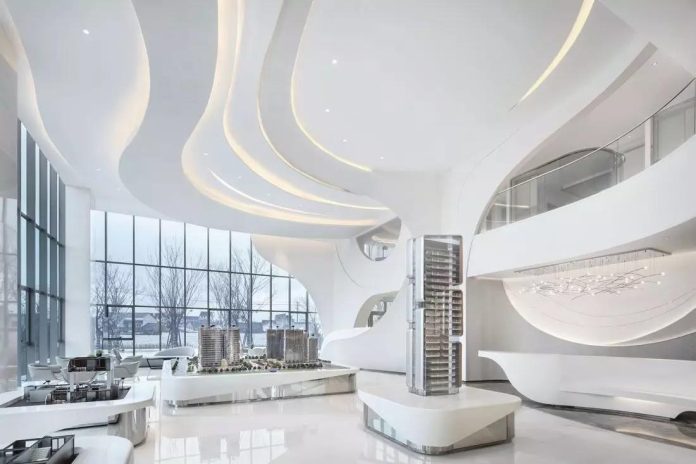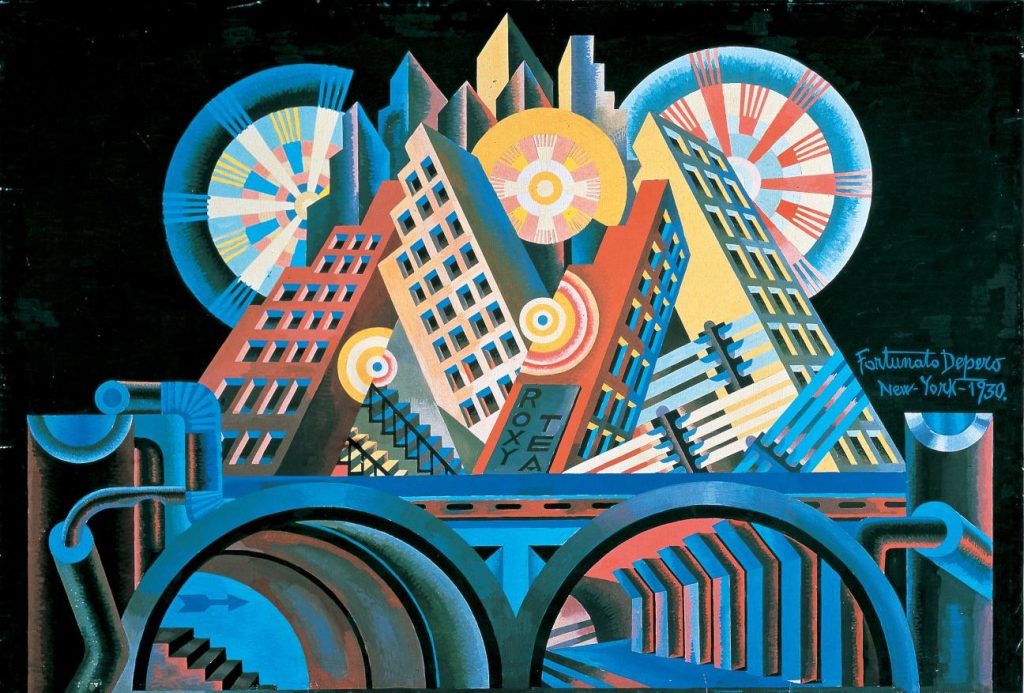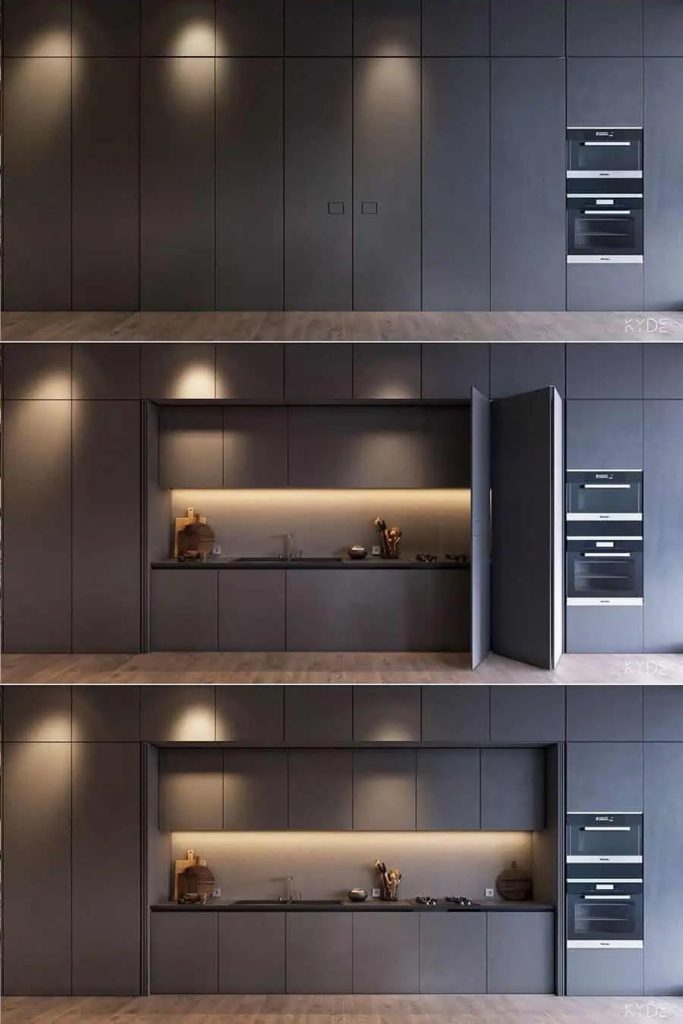
In the ever-evolving world of interior design, the concept of Futuristic Interiors pushes the boundaries of imagination, evoking images reminiscent of the awe-inspiring landscapes often seen in science fiction films. These spaces are not just intriguing; they showcase the fusion of artistry and cutting-edge technology.
The word “futuristic” conjures visions of an imaginary world teeming with ultramodern experiences, from innovative equipment and design features to ground-breaking architectural façades. It extends its influence even to the very heart of our daily lives – our homes.
In its literal sense, “futuristic” relates to the future, a tantalizing glimpse into the possibilities that lie ahead. While we may not possess the ability to physically traverse time, Futuristic Interiors grant us the opportunity to bring the future into the present. They challenge conventional design norms, ushering us into a realm where interior spaces become a canvas for innovation, beauty, and sustainability.
The Birth and Spread of Futurism: A Cultural Revolution
Futurism, a term coined by the poet Filippo Tommaso Marinetti, found its roots in Italy during the early 20th century. Marinetti’s influential work, “Manifesto del Futurismo” in 1909, left a profound impact on various facets of Italian art. This movement rapidly spread through the Italian artistic community, permeating virtually every form of creative expression, including ceramics, painting, sculpture, theatre, literature, music, interior design, and architecture.

A dynamic artwork by Fortunato Depero – an Italian futurist painter, writer, sculptor, and graphic designer
Among the notable figures of this movement was the architect Antonio Sant’Elia, who skillfully translated the futuristic ideals into the urban fabric of modern cities. He envisioned these cities as functional organisms characterized by dynamism, clean lines, and the harmonious coexistence of humanity and machinery at their core.
At its core, Futurism was a radical rejection of the status quo, wholeheartedly embracing the revolutionary possibilities of a technologically-driven culture. This movement endeavored to break free from the constraints of the past and create a fresh visual language that mirrored the era’s industrialization and technological advancements. In this context, the concept of Futuristic Interiors began to take shape, reflecting the dynamic spirit of the age.
What is Futuristic Interior Design?

Futuristic interior design is a fusion of sleek simplicity and advanced technology. It places a strong emphasis on uncluttered aesthetics, functional utility, and an innovative use of space. This design approach frequently incorporates geometric shapes and vibrant neon lighting, resulting in visually impactful environments that are equally practical for daily living.
Fundamentally, futuristic design rebels against convention, taking inspiration from the avant-garde principles of the Futurism movement. It envisions a future where technology seamlessly integrates with our surroundings, promoting efficiency and ease of use.
Key hallmarks of this style include a vivid chromatic palette, sweeping lines that convey dynamism and a sense of perpetual motion, as well as deliberate asymmetry. Walls and corners may feature angular cut-outs, while the flooring often showcases undulating horizontal patterns, creating a dynamic visual effect.
In essence, futuristic interior design beckons us to embrace spaces that are not only aesthetically stimulating but also aligned with the demands of our modern, tech-driven lifestyles.
Elements of Futuristic Interior Design
Numerous concepts and elements play a pivotal role in shaping the landscape of futuristic interior design. Below is a compilation of selected strategies and illustrative examples that underscore this transformative approach.
- Sleek Lines and Geometric Patterns
Futuristic interior design hinges on the strategic use of lines and geometric shapes. Clean, straight lines infuse spaces with modernity and simplicity, whether in architectural structures or furnishings. Geometric shapes like squares and triangles, often asymmetrical, add sophistication and dynamism. They assist in spatial organization and interact with lighting to create captivating effects.
Curved straight lines continuing from ceiling to wall | Image credit: pinterest.com 
Sharp angular design continued from top to wall | Image credit: behance.net (Burak LAFCI) 
Trapezoidal forms with sharp angles with simple lines | Image source: home-designing.com - Futuristic Furniture
Characterized by its avant-garde designs and innovative materials, futuristic furniture pieces embody both form and function. Sleek, minimalistic lines and unconventional shapes define this furniture, often incorporating materials such as metal, glass, leather and plastics. Ergonomics and comfort remain integral, but with a cutting-edge twist.
Smart furniture is increasingly prevalent, with integrated technologies like built-in speakers, charging ports, and even responsive, shape-shifting designs. These elements, combined with a bold chromatic palette, create striking atmosphere, ultimately contributing to the futuristic interiors’ allure and practicality.

Futuristic bedroom | Source: livinator.com 
Futuristic living room with furniture and surface treatments in dynamic forms | Source: livinator.com - Transparent and Reflective Materials
The use of reflective and transparent materials is a defining element of futuristic interior design, imparting a sense of spaciousness and innovation.
Reflective surfaces, like mirrored walls, glossy acrylics or polished metallic finishes, create an illusion of expanded space and amplify the play of light, while imparting a sense of modernity, futurism and sophistication to the space.
Transparent materials, such as glass walls, acrylic furnishings, or see-through partitions, add a layer of sophistication while maintaining an open, airy ambiance. These materials encourage natural light penetration, connecting interior spaces with the external environment.

Space-like washroom with glossy acrylic finish & glass | Image credit: qssupplies.co.uk 
A futuristic kitchen with black chrome, metallic accents, and neon lights.| Image credit: behance.net (Burak LAFCI) - Sci-fi cues and influences
Many futuristic interior designs find inspiration in sci-fi films. Spaceships, sleek technology, and utopian visions often serve as muse.
Metallic surfaces, holographic displays, and LED lighting that mimic interstellar landscapes are incorporated. Bold color palettes and unconventional shapes evoke extra-terrestrial worlds.
The result is a design that seamlessly integrates fantasy with functionality, inviting occupants to explore and interact with the future in a setting that’s both visually engaging and functional.

Sci-fi inspired futuristic bedroom | Source: millerinteriordesign.com - Camouflaged Storage and Concealed Spaces
In the pursuit of a minimal futuristic design, the integration of innovative storage solutions, such as hidden compartments and concealed spaces, becomes imperative. This design approach fosters an environment where every inch serves a purpose, contributing to the futuristic interiors’ clean and streamlined aesthetics.
Walls may conceal cabinets or pull-out shelving, and staircases double as storage units. Innovative mechanisms like pop-up countertops and retractable seating further maximize utility.
These features allow you to discreetly stow away unnecessary items, thus embodying a clutter-free and space-efficient approach that aligns with the style’s forward-thinking ethos.

Concealed kitchen countertop | Image credit: ky-de.com 
Pop up electrical sockets | Image credit: carousell.sg - Futuristic Illumination – LED and Neon Lights
Lighting stands as a pertinent element when infusing a futuristic ambiance into interior design. Futuristic interiors take a departure from conventional lighting fixtures like table lamps and chandeliers is evident, giving way to the use of sleek and contemporary illumination sources.
This shift towards modernity finds its expression through neon and LED lights, which serve as transformative design elements.
LED lighting, with its energy-efficient and long-lasting properties, offers flexibility in color and intensity, enabling the creation of dynamic and immersive atmospheres. Neon lights, known for their vibrant, otherworldly glow, add a retro-futuristic touch, evoking a sense of nostalgia while remaining contemporary.
These lighting elements are strategically integrated into ceilings, walls, and furniture, illuminating spaces with a futuristic flair. Besides providing functional lighting, they also serve as statement pieces, enhancing the futuristic interiors’ visual appeal and technological sophistication.

Futuristic gaming room with neon-lit ceiling and wall panels | Source: yaundesign.asia - Smart Home Technology
In the on-going digital era, Smart home technology is a cornerstone of futuristic interior design, seamlessly blending convenience, efficiency, and innovation. These integrated systems encompass lighting, climate control, security, and entertainment, all at the touch of a button or a voice command. They include touch-controlled blinds, doors, lighting, and cabinet systems, as well as Wi-Fi-enabled appliances that simplify daily life.Futuristic interiors integrate these systems into ceilings and walls, with LED strip lights and responsive electronic interfaces. This convergence of design and technology underscores the future of interior living.

Smart home system control | Image credit: beyondkey.com
Conclusion
In the world of futuristic interior design, the potential knows no bounds, much like the limitless scope of our imagination. Futuristic interior design is just like our future, holding a sense of uniqueness and wider scope for imagination. There are no set rules or limitations. As the saying goes, just as an individual shapes their own future, they also have the power to craft their futuristic interior spaces according to their tastes, personality, and creative vision.
While the Futurism movement may have waned, its lasting impact on interior design remains palpable. Futuristic Interiors persist, drawing us in with their fusion of minimalist ingenuity and state-of-the-art technology. They invite us to envision a future where design seamlessly embraces sustainability and innovative aesthetics, offering boundless opportunities for personal expression and imaginative exploration.

Well researched and highly interesting